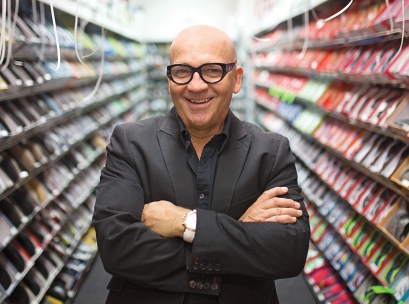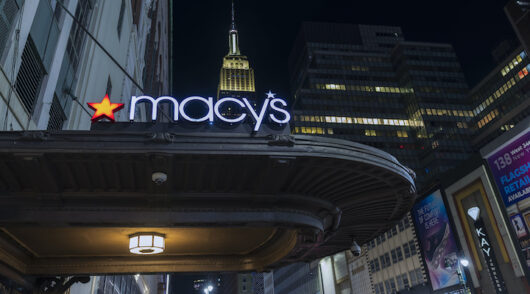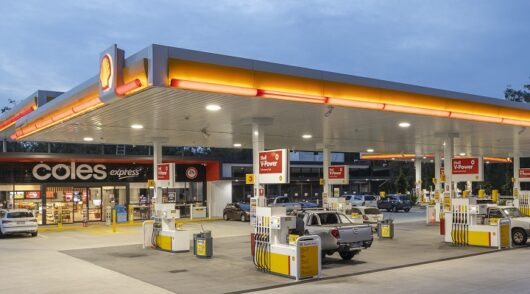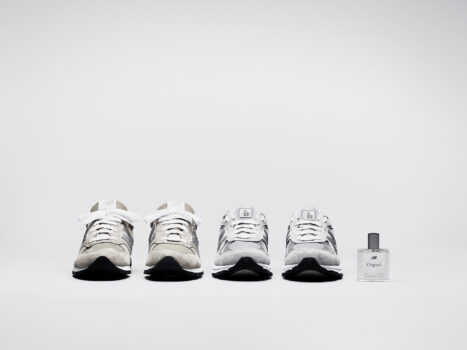 John Charlton opened the first Spend-less Shoes in Glenelg, South Australia, in 1988. The high-volume, low-cost business was a far cry from Charlton’s first retail job selling footwear for David Jones, but the model of allowing customers to self-select their own shoes by size – a concept that was popular in the US but less so in Australia at the time – proved to be a success.
John Charlton opened the first Spend-less Shoes in Glenelg, South Australia, in 1988. The high-volume, low-cost business was a far cry from Charlton’s first retail job selling footwear for David Jones, but the model of allowing customers to self-select their own shoes by size – a concept that was popular in the US but less so in Australia at the time – proved to be a success.
Today, there are more than 200 Spend-less Shoes around Australia, and the privately owned business is looking for opportunities to expand online and through partnerships with other retailers. It’s all part of Charlton’s plan to survive in today’s more “brutal” retail landscape.
Here, Charlton shares his top priorities for 2019 and why he is happy now when customers return something in-store.
Inside Retail Weekly: Can you provide a snapshot of Spend-less Shoes today: how many stores do you have, how many employees do you have, how many markets do you operate in, what are your annual sales?
John Charlton: We have 215 stores in every state and territory in Australia and around 1000 employees today. We’re always looking at opportunities to grow [overseas], and we still are. But I suppose right now, it would be prudent to make sure our house is in order. The first half of 2018 was great, but the second half was brutal. We have to develop in the online and IT area more to make sure we’re survivors in a more brutal environment. There were some unprecedented changes in 2018 that we haven’t seen before. It’s amazing that they came so quickly.
IRW: ShopperTrak recently reported a double-digit drop in foot traffic in December 2018. As Brand Collective’s Martin Matthews recently pointed out, most retailers haven’t seen a drop like that ever before…
JC: That was the lightbulb moment for me. I kept thinking, what are we doing wrong? Is our stock wrong? Why did we do so well last year and not this year? And then I remember visiting a shopping centre during the school holidays, and I could get a park wherever I wanted. It hit me then that traffic was down. We have to adapt to that environment now. People ask if it’s an apocalypse or a renaissance. In my view, it’s a renaissance, because so many of the old rules are changing. Where do you advertise? Online? Catalogues? It’s all changing.
Just to give you an example, December was tough, but the first week of December was really tough because you had the hangover from Black Friday. This year, Black Friday went absolutely nuts, so people spent all their money that week. Normally, in the lead-up to Christmas, the first week of December is good, but it didn’t happen this year. But of course, the industry has to take a look at itself too. If you walked around shopping centres on Black Friday, you would have seen many retailers advertising 40 per cent off storewide. Well, that’s just lazy retailing, because your best sellers sell in any case, so all you’re doing is selling your best sellers at 40 per cent less, and then you don’t have stock in your December period.
So I think we’ve got to be smarter in dealing with Black Friday and such events. With footfall being down in centres, there’s no safe space under the sun. We’re all affected. A successful retail business today needs to be so much more than just a storefront or a website. Whether you’re in the store, online, IT support, it’s all crucial now. The people making your shopping cart easier to access are just as important as the people working in your store. It’s all customer service now.
We just won the retail employer of choice award in our category. At a time when we’ve had to make a few tough decisions – we have closed some unprofitable stores in 2018 – it’s just fantastic that our staff have voted us an employer of choice.
With less traffic in shopping centres, your people are more important than ever. If there are fewer customers coming into our stores, then our customer connection and conversion rate is more important than ever, and motivating our team is a bigger issue than ever.
The days of being in every centre are probably over, because you can’t carry unprofitable stores. You used to be able to carry them because the really good ones made up for the ones that weren’t so good. But if there are fewer customers in the centre, the good ones won’t be able to make up for it anymore.
The other thing I find amazing right now is that landlords are increasing paid parking at their centres. I know they say they can’t have people parking there all day, but they lived with it up until now. And now you’ve got the threat of online, and fewer people visiting centres… Why would someone drive around a carpark, get frustrated and pay for it, when they could just have something delivered to their home? Why are we making it difficult for them?
You see it happening in more and more centres, it’s just creeping across. A customer will happily pay $40 for something online and rave about getting free shipping, and another one will pay $30 for something and complain about $9 of shipping. It’s the same psychology with paid parking. Customers don’t like it.
IRW: How do you counteract the drop in foot traffic without just resorting to slashing prices?
JC: I think if you look at retail in general, those with the clicks want the bricks, and those with the bricks want the clicks. Imagine if the world were all online, and this new thing called a ‘shop’ opened, where you could touch the product, try it on and bring it home straightaway, do you think online would be under threat? Of course, it would. So there’s an argument for both.
I look at our business now and see that online is growing at an unprecedented rate. Online back-to-school sales were 79 per cent up on the same period last year. But I also look at it and think we have 215 fulfilment centres out there, compared to an online retailer that has just one warehouse in central Sydney.
So we have to grow our click-and-collect, click-and-deliver. It costs a lot of money, but we’re investing in that area. Whatever way the customer wants to shop, we don’t care, as long as we’re selling them shoes.
You’ve got to get the product right; you’ve got to be competitive. There’s less wiggle room for error than there’s ever been. You’re only as good as your data; there’s more analysis than ever of making sure your range is relevant, not too wide because you don’t want to have too many markdowns.
I would be interested to know how many people are really making a lot of money online. There’s no doubt you can sell anything online, but if you’re not making any margin, it’s no good.
IRW: So it’s about reminding customers of the reasons they like to shop in-store…?
JC: When I grew up, people used to watch TV after dinner. Now they’re shopping online. Whether they choose to get it delivered, or they come to the store to get it, all those options are there. No retailer really likes returns, but if the customer comes into the store with a return, you’ve got to say fantastic, because they’re in the store. All of a sudden a return from an online purchase is the greatest opportunity you have to sell them something else.
It’s about getting all of it to work, and it’s not as easy as it sounds. The changes you need to make to your IT and backend are huge and require significant investment, and the culture of the business needs to change from being store-focused to being company-focused. Whatever way we can make the sale, we do it. And that’s a big change.
IRW: In terms of IT investment, is that something you’re doing now?
JC: We’re always doing it, but 2018 was a wakeup call to fast track it.
IRW: What capabilities are you looking to gain from that investment?
JC: We want to be able to sell on every platform available, but you wouldn’t believe the changes you need to make – and the time and money you need to spend – to be able to sell on other people’s platforms. It’s not easy. I think we’re all going to have to collaborate going forward. In order to keep growing the business, we’re going to have to collaborate with online-only platforms, or other retailers. We might end up selling shoes on a fashion retailer’s website in the future, and we’d have to pay a margin to them.
IRW: Has Spend-less Shoes ever sold through an online marketplace like eBay in the past?
JC: We are now. That’s something we did in 2018.
IRW: What about Amazon?
JC: We’re looking at that. As we sit here today, Amazon has been in Australia for 61 weeks. I don’t know that Amazon has changed the world in Australia, but I think it’s changed the psyche. I think all other websites have lifted.
I fully respect Amazon, and we’re talking to them and looking to engage with them in the future, but by their own admission, it’s steady as she goes [in terms of growth]. But I think they’ve changed the psyche of customers and retailers. We’ve all gotten better at [online]. You don’t get 79.7 per cent up unless you’re better at it. We handle returns better, so the customer isn’t scared of shopping online.
IRW: Still, data suggests that the growth in online shopping hasn’t made up for the slowdown in bricks-and-mortar sales…
JC: No doubt consumer spending is down. In tough times, we all do analysis by paralysis. It’s funny, when you’re flying, you don’t do the same analysis. I think we have a culmination of factors. I think petrol prices went up 22 per cent over the course of 2018, and I can tell you that whenever petrol prices are up, our business suffers, because we’re on the more budget end of the spectrum. But you’ve got to say that falling traffic in shopping centres is a concern. That’s the biggest one.
IRW: Shopping centre owners often talk about turning shopping centres into community hubs to drive foot traffic. But do you think they need to be doing more? Or reducing rents?
JC: They’re going to have to. I’m not picking on them; they’re doing a great job providing fantastic environments in which to retail. They’re probably as good in Australia as anywhere in the world because you have everything: supermarkets, department stores, discount department stores. In the US, you only have department stores and specialty retailers.
But this is a global phenomenon; it’s the same in the US and UK. I don’t think even they [shopping centre owners] saw the drop-off coming. But as they change into community centres, as they increase dining, or wellness centres or dental shops, is that going to help a fashion retailer like me? In my view, no. And therefore the rental for the fashion industry has to have an adjustment.
IRW: Does the current slowdown feel like an unprecedented low point, or is it something that happens every couple of years that you get through?
JC: We had a tough 2014, and I don’t think it’s as bad as 2014 was, and we had a good couple of years after that, but the feeling is different. As I said before, I think we’re in a renaissance, not an apocalypse, but a lot of things are going to have to change. Rents will have to come down. You’ll have to find the best way to market and advertise yourself.
Shopping centres aren’t going to die, but we’re in the middle of a shift. And the good retailers are going to have to figure out how to adapt, and that means getting your rent right. You’re not going to be able to afford being in every centre like you used to be, and that means being in the right centre with the right store and the right rent. I think there will be a lot of that going on.
IRW: What else is a priority for you in 2019?
JC: I think those things I mentioned – growing online, collaborating with other retailers and making sure occupancy is something you can afford because you won’t have the fat to carry it off – are the key things.
IRW: Have there been any changes on the supply side of the business that would make it harder or easier for you maintain margin, as you consider collaborating with other retailers?
JC: If you talk about factories that are making shoes for the world, sales in the UK are clearly down. America is up a bit, but I think there’s a lot of nervousness everywhere in the world. All the factories we deal with are feeling those pressures. If someone’s got 11 factories in China, they’re looking to go to nine to keep them competitive on price. I’d like them to keep 11 and be more negotiable on price! Of course, China is also getting dearer.
IRW: I understand you got your start in retail selling shoes at David Jones. What are your thoughts on the competitiveness of department stores today?
JC: Clearly it’s shrinking. I think 10 years ago, department stores used to be around 40 per cent of the sales of shopping centres. I think it’s closer to 30 per cent today, so it’s been an enormous change.
I think they’ve got an enormous opportunity, but in my experience, their websites are clunkier and harder to shop on than Amazon. And if I want to go into a store, I walk into the ground floor and get the atomiser invasion and see staff everywhere and think this is fantastic… But then I go to the department I want to go to and there’s no one there, or it’s a concession area and they say I work for X brand, I can’t help you. Or I do buy something, and it takes 10 minutes for the transaction to go through.
They’ve got a lot to get right. It’s easy to say, but harder to do. I think they’ll get smaller and more efficient, but it’s taking them a long time to do.
IRW: Do you think anything has changed from the time when you were an employee? Do you think there was more investment in training in the past?
JC: I think the specialties have just gotten so much better over the years. Department stores are fighting against them, but they don’t have the expertise. Not that they play in our part of the footwear industry, but years ago, Myer used to have the bargain basement and have budget footwear in that area. But we’re so focused on it.
All those specialty shops that line the malls are good operators and they’ve taken that business away from the department stores. There’s still room for a one-stop shop, but you can’t have a David Jones everywhere, because not every suburb can handle an upmarket range. That leaves an opportunity for Myer, but they’ve got to concentrate on what they do the best in.





